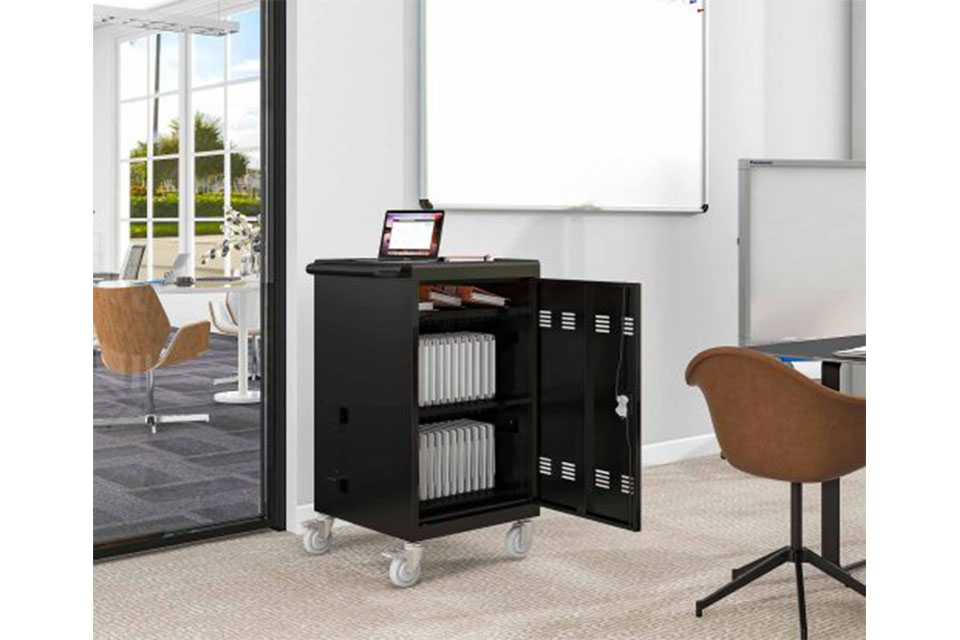Declutter Your Office: The Role of Charging Cabinets in Modern Workspaces
Summary
Decluttering your office is becoming increasingly vital in modern workplaces, where an organized environment significantly enhances employee productivity and satisfaction. One essential solution to achieving this is the implementation of charging cabinets—specialized storage units designed to manage, charge, and secure multiple electronic devices, such as laptops and smartphones. These cabinets not only streamline the charging process but also minimize clutter, ensuring a professional and efficient workspace that reflects a company’s commitment to employee well-being and operational efficiency.
The integration of charging cabinets offers a range of benefits that address common workplace challenges, including reduced downtime and enhanced organization. By centralizing charging capabilities, these units eliminate the chaos of scattered chargers and power outlets, allowing employees to focus on their tasks without the distraction of disorganized devices. Moreover, many charging cabinets incorporate smart technology that optimizes charging speeds, prolongs device battery life, and prevents overcharging, contributing to overall device management and sustainability within the workplace.
Charging cabinets find applications across various sectors, including education, retail, and corporate environments, demonstrating their versatility and importance in contemporary workspace design. They cater to diverse technological needs, accommodating a range of electronic devices while promoting a clutter-free atmosphere. Notably, their effectiveness in enhancing employee morale and fostering a collaborative spirit has made them a popular choice among organizations seeking to boost productivity and innovation.
While the advantages of charging cabinets are clear, organizations must also consider potential challenges, such as installation costs, maintenance, and security. Striking the right balance between accessibility and data protection is crucial, particularly in environments where sensitive information is stored. As businesses increasingly prioritize efficient space management and employee satisfaction, charging cabinets represent a forward-thinking approach to office organization and modernization in the digital age.
The Need for Decluttering in Modern Workspaces
Importance of an Organized Workspace
Decluttering in modern workspaces is essential for fostering productivity and employee satisfaction. A clean and well-organized environment can significantly reduce fatigue, improve posture, and enhance focus among employees. By eliminating clutter, businesses create a space that reflects professionalism and attention to detail, which can boost employee morale and motivation.
Psychological Benefits of Decluttering
The psychological impact of workspace design cannot be overlooked. An aesthetically pleasing and organized workspace positively influences the mindset of employees, fostering creativity and a sense of pride in their work environment. When a workspace is free from distractions, employees are more likely to feel motivated and engaged. In contrast, clutter can lead to increased stress and hinder concentration, negatively impacting overall efficiency.
Customization and Personalization
Decluttering goes hand-in-hand with the customization of workspaces. When employees have the opportunity to personalize their work environments, it enhances their sense of ownership and comfort. Custom solutions, such as charging cabinets and desktop organizers, not only help to maintain an orderly workspace but also cater to the unique needs of different teams, fostering a collaborative atmosphere.
By providing tailored storage solutions, companies can reduce clutter and promote employee well-being.
Integration of Technology in Decluttering
Modern office furniture solutions often incorporate technology to assist in maintaining an organized workspace. For instance, desktop charging stations help manage electronic devices while reducing visual distractions. These features not only enhance productivity but also support a seamless transition between tasks, as employees can keep their devices charged and ready for use without cluttering their desks.
Charging Cabinets
Charging cabinets are specialized storage units designed to manage, charge, and secure multiple electronic devices such as laptops, tablets, and smartphones in a centralized location. These cabinets feature multiple charging ports, shelves, and various safety mechanisms, making them essential for both organizational efficiency and device maintenance.
How Charging Cabinets Reduce Device Downtime
Centralized Charging
Charging cabinets streamline the charging process by eliminating the need for scattered chargers and power outlets. By providing a single location where devices can be stored and charged simultaneously, they ensure that all devices are readily available when needed.
Efficient Power Management
Many modern charging cabinets incorporate smart charging technology, which optimizes charging speeds and prevents overcharging. This capability not only extends the battery life of devices but also ensures that they are fully charged within the shortest possible time.
Enhanced Organization
The organization provided by charging cabinets helps businesses manage their devices more effectively, reducing clutter and improving overall productivity. By keeping devices in one location, the risk of losing or misplacing them is minimized.
Key Benefits of Charging Cabinets
Charging cabinets offer numerous advantages, including:
Time Savings: Devices can be charged simultaneously, reducing waiting times for users.
Cost Efficiency: With reduced downtime and extended device lifespan, businesses can save on replacement costs.
Space Optimization: Compact designs help maximize available workspace.
Scalability: Many cabinets can be expanded or customized to accommodate growing technology needs.
Environmental Benefits: Centralized charging can lead to more efficient energy use and less electronic waste.
Applications of Charging Cabinets
Retail and Hospitality
In retail and hospitality settings, charging cabinets help manage devices like point-of-sale (POS) systems and customer service tablets, ensuring they are always charged and ready for use.
Public Services
Libraries, government offices, and community centers utilize charging cabinets to effectively manage shared devices, providing convenient access for users.
Features to Look for in a Charging Cabinet
When selecting a charging cabinet, consider the following essential features:
Device Compatibility: Ensure the cabinet can accommodate the types and sizes of devices used within the organization.
Charging Speed: Look for smart charging capabilities to optimize charging times.
Security Features: Choose lockable cabinets with access control systems to protect valuable devices.
Portability: Mobile charging cabinets with wheels offer flexibility for use across different locations.
Durability: Cabinets constructed from high-quality materials provide long-term reliability.
By incorporating charging cabinets into modern workspaces, organizations can significantly enhance their operational efficiency and maintain a clutter-free environment.
Benefits of Charging Cabinets in the Workplace
Charging cabinets offer a multitude of benefits that significantly enhance workplace efficiency and employee productivity.
Reduced Downtime
One of the primary benefits of charging cabinets is the substantial reduction in device downtime. By ensuring that electronic devices are always charged and ready for use, businesses can minimize interruptions that disrupt workflows and lead to financial losses. A streamlined charging solution helps employees focus on their tasks rather than worrying about low battery levels or disorganized storage, which can lead to misplaced or damaged devices.
Enhanced Organization
Charging cabinets help reduce employee frustration by keeping devices and cables organized and protected. With dedicated storage, businesses can prevent breakage, loss, and theft of devices, ultimately saving money on replacements and maintenance costs. Additionally, a well-organized workspace fosters a more efficient environment, allowing employees to find and access their devices quickly when needed.
Prolonged Device Life
The use of charging cabinets can prolong the battery life of electronic devices by preventing overcharging. Smart charging features ensure that devices are charged only when necessary, reducing the frequency of replacements and associated maintenance costs. This not only benefits the bottom line but also promotes sustainability within the workplace by minimizing electronic waste.
Space Optimization
Many charging cabinets are designed with compact dimensions that allow them to fit seamlessly into various workplace environments. This space optimization is crucial for businesses seeking to maximize available space while maintaining a clutter-free atmosphere. By integrating charging solutions into the office layout, companies can create a more inviting and efficient workspace.
Scalability and Versatility
Charging cabinets come in various sizes and configurations, making them suitable for a wide range of settings, from small businesses to large enterprises and educational institutions. This scalability allows organizations to choose solutions that best fit their needs, ensuring that they can adapt as their device requirements evolve over time.
Environmental Benefits
By incorporating smart charging features, charging cabinets help reduce energy consumption, promoting sustainability in the workplace. These environmentally friendly solutions align with corporate social responsibility (CSR) initiatives and can enhance the company's reputation as a leader in sustainable practices. As businesses aim to lower their environmental footprint, implementing charging cabinets serves as a practical step toward achieving these goals.
Supporting Various Industries
Charging cabinets are particularly beneficial across multiple sectors, including education, healthcare, and corporate environments. Schools and universities utilize them to manage devices used in digital learning, ensuring that tablets and laptops are readily available for students and teachers. In healthcare settings, charging cabinets are essential for storing and charging devices critical for patient care and record management. Corporately, businesses rely on these cabinets to maintain their fleet of devices, ensuring employee productivity remains high.
Best Practices for Implementing Charging Cabinets
Assessing Needs and Compatibility
Before selecting a charging cabinet, it is essential to assess the specific needs of your organization. Consider the types of devices that will be stored and charged, ensuring that the cabinet supports the sizes and compatibility of these devices. Additionally, evaluate the expected charging speed; opting for cabinets with smart charging capabilities can significantly enhance efficiency by optimizing charging times.
Strategic Location and Installation
Choosing the right location for the charging cabinet is critical. It should be easily accessible to employees to facilitate convenient charging while also considering the need for sufficient power outlets. When planning the installation, anticipate future needs by preparing for more electrical infrastructure than currently required. For instance, if planning to install four chargers, preparing for eight may reduce costs when adding more chargers later. Moreover, keep in mind that installation in challenging areas may incur additional costs due to accessibility issues.
Security and Organization
Security features are paramount for charging cabinets, especially in settings where valuable devices are stored. Lockable cabinets with access control systems can prevent unauthorized access and theft. Additionally, effective cable management is crucial to maintain an organized workspace; ensure that the cabinet design allows for tidy cable arrangements to prevent tangling and facilitate maintenance.
Employee Engagement and Training
To maximize the benefits of charging cabinets, engage employees by communicating the availability and advantages of using these systems. Providing training on how to properly use the cabinets and emphasizing their role in enhancing productivity can foster a culture of responsibility and care for shared resources.
Monitoring and Maintenance
Once implemented, it is essential to monitor the usage of the charging cabinets to understand patterns and ensure their reliability. Regular maintenance checks will help keep the cabinets fully functional, thereby avoiding downtime that could disrupt workflow.
By following these best practices, organizations can effectively implement charging cabinets that not only declutter their office spaces but also enhance overall productivity and efficiency in modern work environments.
Case Studies
Implementation of Charging Cabinets in Office Environments
The integration of charging cabinets within modern workspaces has shown significant benefits in various case studies across different industries. One prominent example includes a design and manufacturing company that incorporated charging stations to enhance employee productivity and satisfaction. By offering charging cabinets equipped with multiple ports, employees could charge their devices conveniently while maintaining a clutter-free workspace. This move not only improved employee morale but also reduced the time spent searching for outlets, thereby allowing for increased focus on work-related tasks.
Boosting Employee Retention
Another case study reveals that a leading tech firm adopted charging cabinets as part of its employee retention strategy. The installation of EV charging stations alongside traditional charging cabinets demonstrated a commitment to sustainability, aligning with the values of their predominantly millennial workforce. This initiative resulted in a noticeable increase in job applications, as potential hires recognized the company's dedication to environmentally friendly practices. Furthermore, the presence of these charging solutions enhanced the company's brand image, contributing to its competitive edge in the market.
Enhancing Learning Environments
In the educational sector, a school implemented the Kwik IQ Pro charging solution to manage multiple devices effectively. By deploying charging cabinets in classrooms, teachers reported a significant decrease in downtime related to device charging. This initiative supported a seamless e-learning experience, fostering an engaged learning environment. The easy management of devices through organized charging stations not only benefited educators but also helped students maintain access to technology, crucial for their academic success.
These case studies illustrate the transformative impact of charging cabinets in various settings, highlighting their role in improving efficiency, employee satisfaction, and overall productivity in modern workspaces.
Challenges and Considerations
While charging cabinets offer numerous benefits for modern workspaces, there are several challenges and considerations that organizations must address when integrating these solutions.
Installation Costs and Complexity
The installation of charging cabinets can vary significantly based on the type and complexity of the unit. Basic models may incur an installation cost ranging from $100 to $400, depending on factors such as cabinet size, required electrical work, and any custom features. Larger and more complex cabinets, particularly those that require hardwiring or specialized setups, may demand additional labor and materials, thus increasing overall costs. It is essential for organizations to consult with licensed electricians to ensure safe and proper installation, which can also impact the timeline of deployment.
Maintenance and Repair
Routine maintenance is crucial for the longevity and reliability of charging cabinets. Although general maintenance costs are relatively low, averaging up to $400 annually per charger, unexpected repairs can be costly, especially if the equipment is no longer under warranty. Establishing a maintenance plan or service agreement with a trusted provider can mitigate these issues by ensuring regular check-ups and prompt repairs, thus preventing potential downtimes and extending the lifespan of the equipment.
Space Optimization and Design
While charging cabinets can enhance space organization, their design must be carefully considered to fit seamlessly within the workspace. Compact designs are often necessary to maximize available space, but organizations should also consider the aesthetic integration of charging solutions into existing office layouts. Custom-designed cabinets typically have higher installation costs compared to pre-fabricated models, which could strain budgets if not planned accordingly.
User Experience and Accessibility
User-friendly features are vital for the successful adoption of charging cabinets in workplaces. Charging solutions should be easily accessible to employees to avoid frustration and ensure optimal utilization. Additionally, ensuring that these cabinets support various device types and sizes can further enhance the user experience, allowing for flexibility in a diverse tech environment.
Environmental Impact
Finally, organizations should consider the environmental implications of their charging infrastructure. Smart charging features can help reduce energy consumption and promote sustainability, which aligns with many companies' corporate social responsibility goals. However, the energy demands of charging cabinets must be assessed within the context of overall power usage in the office, ensuring that the environmental benefits outweigh the associated energy costs.
Future Trends in Office Decluttering and Charging Solutions
Integration of Smart Technology
As workplaces continue to evolve, the integration of smart technology into charging solutions is anticipated to play a significant role in decluttering office environments. Smart charging stations equipped with IoT capabilities can optimize charging cycles based on real-time data, thus reducing downtime and ensuring devices are charged when needed without the clutter of excessive cables. These technologies can also send notifications to users regarding charging status, thereby minimizing idle devices and encouraging efficient use of charging resources.
Enhanced Design for Aesthetics and Functionality
The design of charging stations is expected to become more sophisticated, blending seamlessly into office decor while maintaining functionality. Charging towers and pads are likely to be designed with an emphasis on aesthetics, offering elegant solutions that do not detract from professional workspaces. Future designs may incorporate wireless charging capabilities and cable management systems that route cords discreetly, contributing to a more organized and visually appealing environment.
Focus on Employee Well-Being
Organizations are increasingly recognizing the link between workplace organization and employee well-being. By providing convenient and accessible charging solutions, companies can enhance productivity and reduce stress associated with low battery interruptions. The trend toward creating organized, clutter-free workspaces is anticipated to grow, with an emphasis on ergonomic furniture and designated charging areas that encourage both focus and collaboration.
Sustainability and Energy Efficiency
As sustainability becomes a more pressing concern for businesses, future charging solutions are expected to incorporate renewable energy sources such as solar power. This not only helps in reducing operational costs but also aligns with corporate responsibility goals aimed at reducing carbon footprints. The rise of eco-friendly charging solutions will likely contribute to decluttering as they reduce the need for multiple power sources and adapters, allowing for a more streamlined approach to device management in the workplace.
Wireless Charging as a Standard
The growing popularity of wireless charging technology is set to further transform office environments. By eliminating the need for cords and connectors, wireless charging can significantly reduce visual clutter and enhance workspace organization. As devices increasingly adopt wireless charging capabilities, businesses may implement these solutions more broadly, facilitating a cleaner and more efficient work environment.
 Mobile Charging Cabinets: Power on the Go for Exhibitions and Concerts
Mobile Charging Cabinets: Power on the Go for Exhibitions and Concerts
 How Charging Cabinets Improve Attendee Experience at Conferences
How Charging Cabinets Improve Attendee Experience at Conferences
 Declutter Your Office: The Role of Charging Cabinets in Modern Workspaces
Declutter Your Office: The Role of Charging Cabinets in Modern Workspaces

